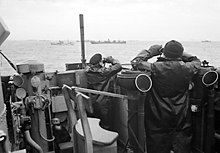
Back الحرب المضادة للغواصات Arabic Sualtı qayıqlara qarşı mübarizə Azerbaijani Противоподводна отбрана Bulgarian ডুবোজাহাজ বিধ্বংসী যুদ্ধ Bengali/Bangla Guerra antisubmarina Catalan Antiubådskrigsførelse Danish U-Jagd German Ανθυποβρυχιακός πόλεμος Greek Guerra antisubmarina Spanish جنگ ضدزیردریایی Persian
This article needs additional citations for verification. (February 2009) |

| Part of a series on |
| War (outline) |
|---|
 |
Anti-submarine warfare (ASW, or in the older form A/S) is a branch of underwater warfare that uses surface warships, aircraft, submarines, or other platforms, to find, track, and deter, damage, or destroy enemy submarines. Such operations are typically carried out to protect friendly shipping and coastal facilities from submarine attacks and to overcome blockades.
Successful ASW operations typically involved a combination of sensor and weapon technologies, along with effective deployment strategies and sufficiently trained personnel. Typically, sophisticated sonar equipment is used for first detecting, then classifying, locating, and tracking a target submarine. Sensors are therefore a key element of ASW. Common weapons for attacking submarines include torpedoes and naval mines, which can both be launched from an array of air, surface, and underwater platforms. ASW capabilities are often considered of significant strategic importance, particularly following provocative instances of unrestricted submarine warfare and the introduction of submarine-launched ballistic missiles, which greatly increased the lethality of submarines.
At the beginning of the twentieth century, ASW techniques and submarines themselves were primitive. During the First World War, submarines deployed by Imperial Germany proved themselves to be a capable threat to shipping, being capable of striking targets even out in the North Atlantic Ocean. Accordingly, multiple nations embarked on research into devising more capable ASW methods, resulting in the introduction of practical depth charges and advances in sonar technology; the adoption of the convoy system also proved to be a decisive tactic. After a lull in progress during the interwar period, the Second World War would see submarine warfare and ASW alike advance rapidly, particularly during the critical Battle of the Atlantic, during which Axis submarines sought to prevent Britain from effectively importing supplies. Techniques such as the Wolfpack achieved initial success, but became increasingly costly as more capable ASW aircraft were introduced. Technologies such as the Naxos radar detector gained only a temporary reprieve until detection apparatus advanced yet again. Intelligence efforts, such as Ultra, had also played a major role in curtailing the submarine threat and guiding ASW efforts towards greater success.
During the postwar era, ASW continued to advance, as the arrival of nuclear submarines had rendered some traditional techniques less effective. The superpowers of the era constructed sizable submarine fleets, many of which were armed with nuclear weapons; in response to the heightened threat posed by such vessels, various nations chose to expand their ASW capabilities. Helicopters, capable of operating from almost any warship and equipped with ASW apparatus, became commonplace during the 1960s. Increasingly capable fixed-wing maritime patrol aircraft were also widely used, capable of covering vast areas of ocean. The Magnetic Anomaly Detector (MAD), diesel exhaust sniffers, sonobuoys and other electronic warfare technologies also became a staple of ASW efforts. Dedicated attack submarines, purpose-built to track down and destroy other submarines, became a key component as well. Torpedo carrying missiles, such as ASROC and Ikara, were another area of advancement.